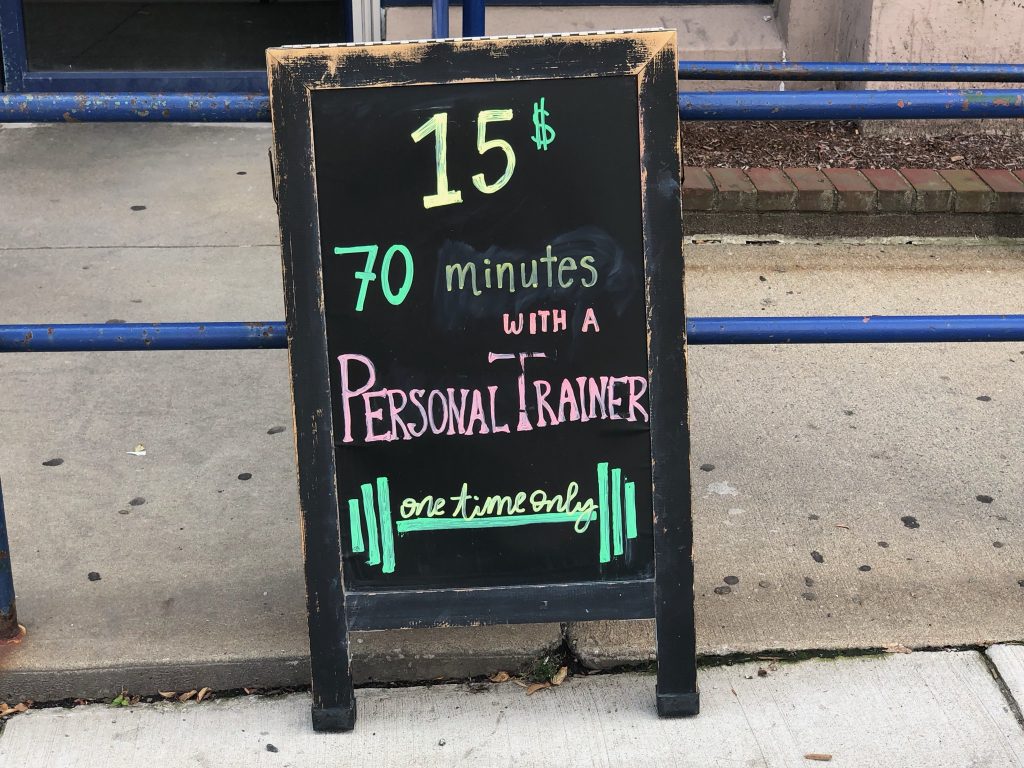There’s no shortage of topics to debate in today’s world.
- Keto vs. CICO?[footnote]CICO = Calories In, Calories Out.[/footnote]
- How to best tackle the issue of healthcare?
- Is Pluto a planet?
I don’t have a horse in the race on any of the above, except:
- Keto zealots are the worst.
- We need to be more PROACTIVE than REACTIVE with regards to healthcare.[footnote]Free gym memberships and personal chefs for everyone![/footnote]
- You’re goddamn right it’s a planet.
Nevertheless, when it comes to choosing your team – or side of the fence – with any topic I always say the real right answer is…
…it depends.
It’s rare for something to be so clear-cut and definitive; there’s always a degree of nuance and extenuating factors to consider.
Seriously, Pluto’s a planet.[footnote]Okay, technically, a dwarf planet. But still.[/footnote]

Dangers of the Discount Trainer
I’m going to just come right out and say it: I’m not a fan of trainers offering discounts for their services. Now, I say this with a grain of salt because I completely understand (and respect) that it’s a delicate matter and that there’s a number of factors to consider.
For example, I think it makes a lot of sense for larger, commercial gyms to offer discounts.
In Boston, like any major city, there are several notable, big chain commercial gyms vying for people’s attention (and wallets):
- Equinox
- Boston Sports Club
- HealthWorks
- LifeTime Fitness
- 24 Hour Fitness
- Golds
- Planet Fitness
- Beacon Hill Athletic Club
In addition there’s dozens of mid-level commercial gyms (not chains, but pretty big) peppered throughout the city, not to mention a CrossFit box in every major neighborhood. That’s a lot of competition and it makes sense that many of them would offer a free consultation or discounted introductory rates on training to entice more people to join.
Moreover, and as Cressey Sports Performance business director, Pete Dupuis, has noted in the past: Roughly 30% of people who are offered free consultations actually end up taking advantage of them.
“This may be a solid conversion rate from the perspective of the commercial gym owner, but not for the independent contractor who doesn’t see a single penny of the monthly membership dues these potential leads are paying. A 30% conversion rate tells me that 7 out of 10 people decided that something for nothing was actually worth nothing.”
As a small business – and more to the point, as a gym that only offers personal and semi-private training (no open gym or classes) – I don’t have the luxury of hundreds (if not thousands) of people paying a membership fee just to walk through the doors.
Why would I offer my services and time at a free or discounted rate when I have bills to pay?[footnote]Let me back track a bit. This is not to insinuate that I have never offered discounted training to any of my clients. My buddy Jordan Syatt chimed in on this conversation on Twitter the other day and brought up a fair point (to which I agree): “I give discounts all the time. Some of my greatest, longest-term clients have started by me giving them a discount. I think the dogmatic viewpoints against discounts in the “entrepreneur” circle is more of a way to look good to peers rather than it actually being a smart move.”
My only counterpoint is that I’d be reluctant to make this a common practice. Offering a (reasonable) brief discount during the dog days of summer to help get people in the door, a long-time client a free Birthday session, or a one-time discount to current clients who refer business to you is one thing, but relying on the “discount mindset” long-term to grow (or even maintain your business) is a stretch and one I feel won’t make financial sense for most.
Again, it depends.[/footnote]
I can hear the cacophony of pitchforks now.
“But Tony, if you offer free/discounted stuff it’s less intimidating and allows people to see whether or not you’re a good fit.
Stop being such an uppity a-hole!”
To that Point
1. Try walking into a hair salon, attorney’s office, or, I don’t know, Gringotts Bank and ask someone for 30-60 minutes of their time in order to sample the goods and to see if “you’re a good fit.”
HAHAHAHAHAHA – no, seriously, do it.
UPDATE: I should add that it’s not lost on me there’s a bit more robustness to the client-coach relationship compared to the client-attorney relationship. Helping someone to change their behavior takes a lot more nuance. That said, it’s one thing to offer complimentary sessions/discounted rates in conjunction with a clear-cut on-boarding protocol geared towards improving the client experience.
My good friend Todd Bumgardner, owner of Beyond Strength Performance in Sterling, VA, remarks that their conversion rates are very high utilizing a heavily discounted first month of training for new members.
But that’s also because they’re laser focused when it comes to their systems; new members go through a thorough “itinerary” in order to proceed.
And it’s another thing altogether to just haphazardly toss out discounts for the sake of generating some quick revenue.
2. This is my livelihood, not a garage sale.
Sorry not sorry.
To that end, I don’t want to sit here, come across as some crotchedy old bastard (GET OFF MY LAWN!), and rag on the notion that you should never discount your rates as a trainer.
I mean, only Sith’s deal in absolutes, right?
Some Pros or When to Offer Discounts
1. You’re New
If you’re a new trainer or coach in the industry, need experience and more eyes on you – particularly in a crowded commercial gym scenario where there’s a few dozen trainers vying for the same thing – then it makes sense to offer some discounted training to build your client roster.
It’s not beneath you to do so.
I did it.
When I was a commercial gym trainer I’d often offer free 15-30 minute “Deep Dives” for on my own time for members:
- Deep Dive: REAL Core Training
- Deep Dive: Learn How to Deadlift
- Deep Dive: Shoulder Friendly Strength Training
- Deep Dive: How Hot is Jennifer Garner in Alias?
As a result I got more eyes on me and would often have members reach out to begin training.
For the more mathematical minded in the crowd, you can also think of it this way courtesy of Finnish coach, Joni Jaakola of Optimal Performance:
“Offer 45 minute free training sessions + 15 minute consultation => client can experience what they are about to sign into => convert 50% of them => fully booked weekly calendar in two months or so.”
2. One-Time Special Offers
My friends over at Mark Fisher Fitness in NYC are huge proponents of offering special one-time only offers of 20-25% off packages when people attend a special class or charity event.
I like this idea.
If you’re already making the time to be at a certain place at a certain time, go for it.
Offer free shit – training, tickle fights, whatever.
People attend a class, you get their names, you offer the offer, and then you follow-up with a PHONE CALL (or text) – people just delete email – for a few weeks to remind them of when the offer expires.
3. It’s August
In the fitness industry, August (in the Northern hemisphere anyway) is…the…worst.
It’s a dead-zone.
Gym floors often resemble the barren, desolate wastelands of Mordor.
Except in this case it’s because people are on vacation in Martha’s Vineyard (and not so much because of the whole Sauron thing).
So, I get it.
Sometimes you have to discount your rates to attract people’s attention and to get bodies on the gym floor.
Totally legit reason.
However, my buddy and I were headed to get some pizza after a killer squat session last week when we walked past this sign located at the main entrance of a gym chain here in Boston:

Now, admittedly, I have zero insights into this business’s numbers or the inner workings of their operation, maybe they’re crushing it, but to me this is what’s wrong with offering discounts…
…especially ones this, shall we say, aggressive.
My Take (the Cons)
Again, offering discounts is not wrong or altogether a waste of time.
There IS a time and place and a way to implement them that can and will behoove your business as well as the (potential) client.
That said, it’s important to remain aware of the concept of anchoring.
If you’re a fan of behavioral economics – such as myself – and read a lot of books on the topic as it relates to decision making and marketing this should be a familiar term.
Via Wikipedia:
“The anchoring effect is a cognitive bias that describes the common human tendency to rely too heavily on the first piece of information offered. … During decision making, anchoring occurs when individuals use an initial piece of information to make subsequent judgments.”
In the case of the above offer ($15 for 70 minutes of training), the more the discount gets away from your full price, the more problems and reticence you’re going to have – from the consumer – when you reveal said full price.
1. Creates Price Sensitivity & Unsustainable Expectations
This is the double-edged sword of anchoring.
“Anchor” your price too far removed from your actual rates and you run the risk of creating a bevy of price sensitive clients who are going to jump ship to the next trainer or gym who offers an even better discount.
Canadian nutritionist, Steph Hnatiuk, agrees:
“I think huge discounts can attract clients who are only willing/able to pay bottom-end rates, and you’re unlikely to wow those people into full-price paying clients if their budget just doesn’t allow it. I think you wind up giving too much of yourself away in the process.”
2. Creates Discounted Effort
Pigging back on the above, in my experience I have found that discounted prices sometimes (not always) creates a culture of discounted effort.
Humans are very loss adverse.
This refers to people’s tendency to prefer avoiding losses to acquiring equivalent gains: it is better to not lose $5 than it is to find $5.
If a client pays my normal rate they have invested in themselves. There’s a degree of “buy in” from the individual to the tune of if they don’t show up – and I enforce my cancelation policy – there’s an inherent loss there.
And people hate loss.
Even more than the Patriots…;o)
Investment = people (usually) go out of their way to put forth some effort and consistency.
They show up.
$15 sessions = “meh, charge me, I gotta catch up on Ballers.”
3. Creates Awkwardness
The less mental gymnastics I have to do as a business owner, the better.
- Who’s coming in today?
- Who needs a new program?
- How many sessions does so and so have left in their package?
- Why am I not wearing pants?
I prefer to keep things simple:
– I use Google Calendar to book my sessions.
– I use Excel to write my programs.
– I have an assistant who tracks all client sessions (and to let me know who needs what when).
– I almost always wear pants.
Too, when it comes to training packages, I also prefer simplicity and go out of my way to not offer a robust array of options because, frankly, I don’t want to have to deal with that dumpster fire.
If I charge Client A “x” (a discount) and then Client B who is charged “y” (no discount) finds out about it, and is like “dafuq, Tony?”, it makes for some awkwardness I’d rather avoid.
Me touching my wife’s butt in public = awkwardness I can handle.
Me not shaving my head for two weeks = awkwardness I can still kinda-sorta handle.
Me explaining why two clients are charged two different rates = no thank you.
4. You Get What You Pay For

Image Inspired by thePTDC.com (^^I did that all by myself ^^)
This is 90% meant to be more than tongue-n- cheek than anything.
But, yeah, you get what you pay for.



